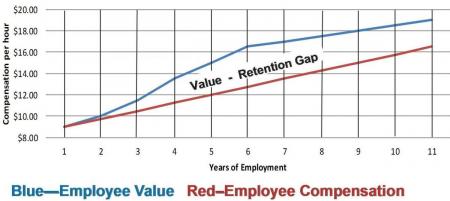
A long time ago, when the issue of employee turnover first entered my life, I had the worst year in my professional life. Our senior field technicians, who were the backbone of our company, were leaving so fast we could not even come close to replacing them. It took five years to create a senior tech. The trend was simple – we were going out of business. Every day began with reports of employees who either had tendered their resignations or just not shown up. With few exceptions, the reported reason for leaving was more money. Most of the offices were already short staffed. We were holding onto bad to marginal employees because we needed warm bodies. Managers would routinely tell me “I have to keep this guy – he is the only GOOD one I have left.”
We offered pay raises which almost never worked - at best we were only matching what they were going to get at the new job. A familiar refrain from the employee was “Why are you willing and able to offer a pay raise NOW?” The company also had a bad reputation for making promises but not following through. So we had two strikes against us before we even started talking. I also had a gut feeling there were lots of other problems which were fueling the exodus.
As with most companies, our technicians value increased as they went through the five year process. We could charge the customer more as the technician learned more and could show he could perform more services. I learned there was little coordination between the value of our tech, what we were charging the customer and what we were paying the tech. Another issue, among many, was the different learning periods of each technician. The techs who learned the fastest were actually the ones being penalized the worst under our current compensation model. Our model was very typical in all industries. Let me stress this, the better employees were being penalized - not rewarded.
Good behavior should always be rewarded
Soon after recognizing this issue, Value PathingTM was born. The above graph is a summary of the difference between what they were being paid versus what we agreed they were worth. Once Value Pathing was instituted – our employee turnover quickly went to zero. Due to the rewarding of good behavior, the average time spent in creating a senior tech went from 5 years to a little over 2 years.
Do you need this level of value in your business?
